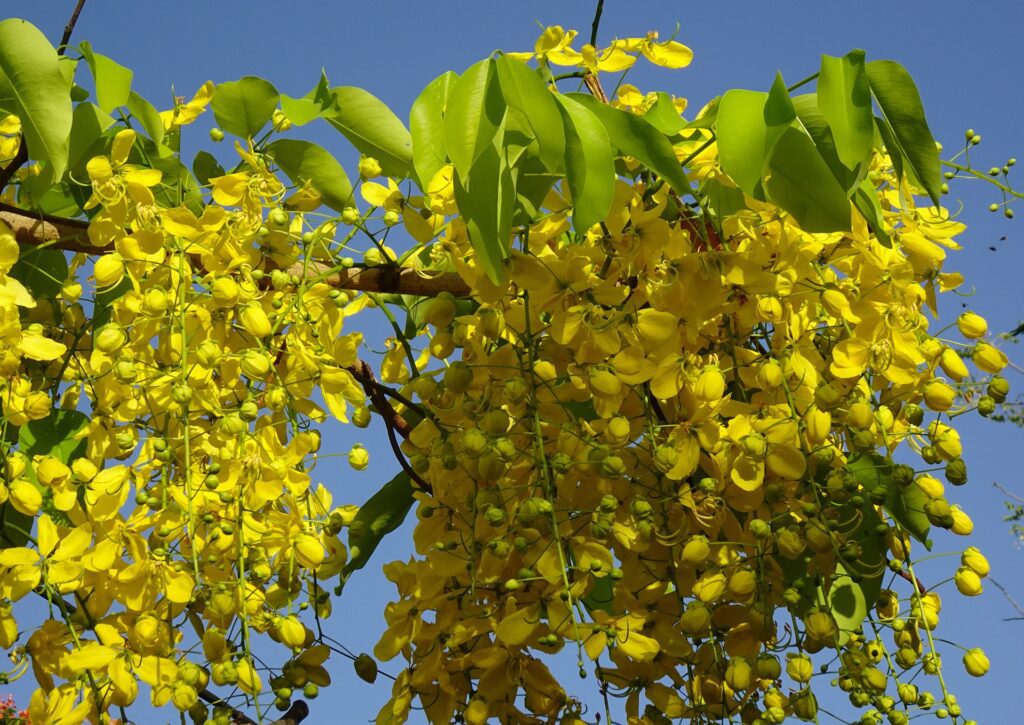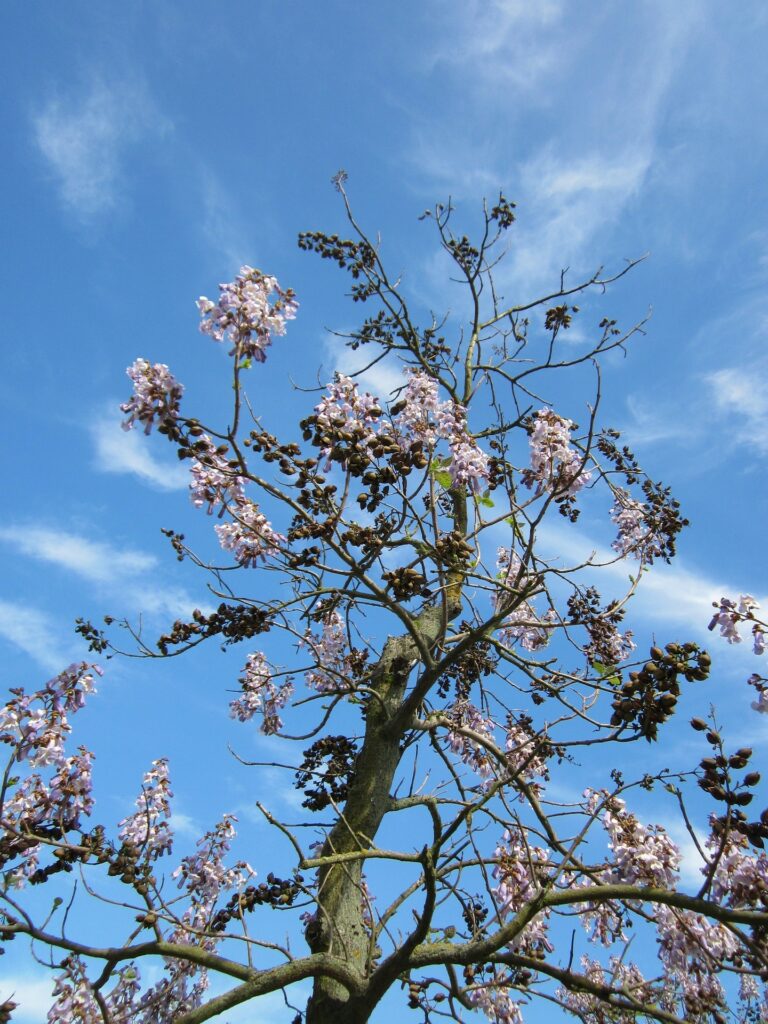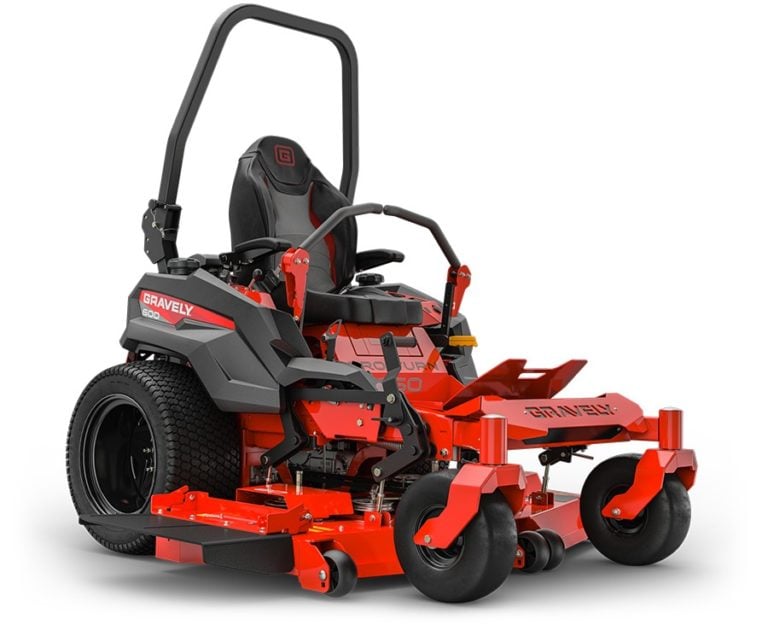Cassia Fistula: Unveiling the Golden Shower Tree’s Benefits
Cassia fistula, a remarkable tree, is famous for its striking yellow flowers that bloom during the warm months. As you walk past this tree, you’ll notice the vibrant color of the flowers, which grow in long cascading racemes, creating an enchanting curtain of yellow. Native to South and Southeast Asia, this tree serves not only as a stunning ornamental piece but also has practical and medicinal applications.

You may come across the Cassia fistula tree in gardens, parks, or lining the streets where its beautiful flowers create a delightful visual impact. The tree’s deciduous nature means it sheds its leaves seasonally, making room for an astonishing bloom. The impressive flowers are not the only thing to admire about this tree, as its fruit, bark, and roots have been utilized for medicinal and other purposes for centuries.
In traditional medicine, various parts of the Cassia fistula tree are essential ingredients for treating a wide range of conditions. From reducing fever to easing skin disorders and addressing digestive problems, the tree’s diverse applications will undoubtedly pique your interest. As you delve deeper into the world of Cassia fistula, you’ll discover a world where nature meets modern science in an enchanting and beneficial way.
Table of Contents
Description and Distribution
Cassia fistula, known as the golden shower tree, is a medium-sized deciduous tree that you can find in tropical and subtropical regions. The tree reaches a height of about 10 to 20 meters and typically has a cylindrical trunk with a grayish-brown bark.
You’ll notice the most striking characteristic of this tree – its beautiful pendulous racemes of bright yellow flowers. These flowers appear in the spring and early summer months, creating a striking visual display. Moreover, the tree bears long cylindrical pods filled with a sweet pulp, encasing its seeds.
In terms of distribution, Cassia fistula is native to the Indian subcontinent and Southeast Asia. It’s especially prevalent in countries like Thailand, where it is the national tree, and the Indian state of Kerala.
Here is a brief overview of the distribution of Cassia fistula:
- Indian subcontinent: India, Pakistan, Nepal, Bhutan, Sri Lanka, Bangladesh
- Southeast Asia: Thailand, Myanmar, Laos, Cambodia, Vietnam, Indonesia, Malaysia, Philippines
Enjoy the visual beauty and ecological value of the Cassia fistula tree in various landscapes, from urban parks to natural forests. As you appreciate its vibrant floral display, remember to admire the diversity and unique qualities of trees worldwide.
Growth and Cultivation
Soil Requirements
To grow a healthy Cassia fistula, it is crucial that you plant it in well-drained soil. You can enhance the soil structure by adding peat moss or compost during the preparation process. This addition will ensure that your plant has access to the necessary nutrients and moisture.
Temperature and Climate
Cassia fistula thrives in a warm climate, with a temperature range of 20°C (68°F) to 30°C (86°F). This plant is best suited for hardiness zones 9 to 11. Make sure that the temperature in your area is within this range before planting the tree.
Sunlight and Watering
Cassia fistula requires full sun exposure for good growth and flowering. Make sure to plant it in a location where it receives at least 6 hours of direct sunlight daily. Water your tree regularly, keeping the soil consistently moist but not waterlogged. Over-watering can lead to root rot and other issues.
Fertilizer
Fertilizer is crucial in the growth and cultivation of Cassia fistula. Use a slow-release fertilizer, as this will provide continuous nourishment for your plant throughout the growing season. Apply the fertilizer according to the package instructions to avoid over-fertilizing, which can cause harm to your tree.
Pruning
Proper pruning is necessary for maintaining a healthy Cassia fistula. Remove any dead or diseased branches, and trim back overly vigorous growth to promote a balanced canopy. Prune your tree after the flowering season to encourage strong growth and better blooms in the next season.
Morphology and Blooms
Leaves
Your Cassia fistula tree has compound leaves, each composed of multiple leaflets. These leaflets are arranged in pairs along the rachis, the central stalk of the compound leaf. You will notice that the leaves are pinnate, meaning they resemble a feather-like shape.
Flowers
During the blooming season, your Cassia fistula tree produces stunning red and yellow flowers. These vibrant flowers form the basis of its nickname, the “golden shower tree.” They appear in pendulous racemes, which are clusters of flowers that hang from the branches. As they grow in abundance, they create a beautiful cascade effect that is sure to captivate anyone.
Fruit
After the flowering stage, your Cassia fistula tree bears fruit. The fruit takes the form of a long, cylindrical pod, which hangs from the branches. Inside the pod, you will find the seeds that are crucial for the propagation of this species.
Seeds
The seeds within the pod are enclosed in a pulp-like substance that becomes hard as the fruit dries. When the time is right, the pod will crack open, releasing the seeds for the next generation of Cassia fistula trees. This ongoing cycle ensures the continuation of this stunning tree species.
Uses and Significance
Ornamental and Landscape
Cassia fistula, also known as the Golden Shower Tree, serves as an excellent ornamental plant. You can often find this flowering tree in gardens, used as a shade tree to provide relief from the sun. Its stunning crown of golden-yellow flowers makes it a popular choice for adding color and beauty to a garden or landscape. Furthermore, the Cassia fistula is well-suited for use as a street tree, lining roadsides and adding aesthetic value to urban environments. Notably, its vibrant flowers have granted it the honor of being the national flower of Thailand.
Medicinal and Pharmacological
Beyond its visual appeal, Cassia fistula possesses a range of medicinal properties. In traditional medicine, various parts of the plant have been used for their potential health benefits. Some common phytochemicals found in the plant, such as tannins, contribute to these properties.
- Stem bark: The bark of Cassia fistula is believed to have antifungal, antibacterial, and anti-inflammatory properties. It has been used in the past for treating skin infections and inflammation.
- Flowers: Rich in flavonoids, the flowers have been used to address digestive issues, constipation, and liver disorders.
- Leaves: The leaves of the Golden Shower Tree have been used to treat a variety of ailments, including diabetes, fever, and joint pain.
Cassia fistula’s pharmacological activities are still being researched, but preliminary studies suggest that it may contain compounds with potential therapeutic benefits.
Timber
Cassia fistula is not only valued for its ornamental and medicinal uses but also for its timber. The wood is moderately hard and heavyweight, making it suitable for use in furniture and cabinetry. The timber is also resistant to termites and other insects, increasing its durability and appeal for various applications in construction and woodworking.
Pests and Diseases
As a cultivator of Cassia fistula, it’s essential to be aware of the pests and diseases that can affect this plant. Monitoring and addressing these issues promptly is crucial for the health of your garden.
Diseases
Several diseases can affect your Cassia fistula, including:
- Leaf Spot: Caused by fungi, leaf spot appears as small, irregular-shaped brown spots on the leaves. To manage this disease, remove the affected leaves and avoid overhead watering.
- Powdery Mildew: This fungal infection appears as a white, powdery substance on the leaves. To control powdery mildew, minimize humidity around the plant and apply an appropriate fungicide.
Pests
There are various pests that can infest and damage your Cassia fistula plants:
- Mealybugs: Small, white insects that feed on plant sap, causing leaf drop and distorted growth. To control mealybugs, remove them manually or use an insecticidal soap.
- Aphids: These tiny, pear-shaped insects suck sap from plant tissues, causing leaves to curl and stunt growth. To manage aphid infestations, release natural predators like ladybugs or apply insecticidal soap.
- Spider Mites: Almost invisible to the naked eye, spider mites feed on plant sap and can cause leaves to become yellow and distorted. To control spider mites, introduce predatory insects, such as predatory mites or ladybugs, or apply a miticide.
Careful monitoring and early intervention will help you maintain your Cassia fistula’s health and beauty. Don’t hesitate to seek professional advice if you are unsure about the best course of action.
Propagation and Germination
Cassia fistula, also known as the golden shower tree, can be propagated easily through seeds. To begin the process, you’ll need to collect ripe, brown pods from the tree. Inside these pods, you’ll find small, dark brown seeds that are ready for germination.
Before you sow the seeds in acontainer, it’s a good idea to soak them in water for 24 hours. This helps to soften the seed coat and encourages faster germination. After soaking, drain the water and prepare your chosen container with a well-draining potting mix. Fill the container leaving about an inch of space from the top.
Next, place the seeds about an inch apart on the surface of the soil. Lightly cover them with additional potting mix or a thin layer of sand. Water the container gently but thoroughly, ensuring that the soil remains moist but not waterlogged.
Maintain a consistent temperature of around 68-77°F (20-25°C) during the germination period. You may use a seedling heat mat if needed. Within 5-15 days, you should start to see small seedlings emerging from the soil.
As the seedlings grow, make sure to provide ample sunlight and continue to monitor soil moisture. When the seedlings have developed at least two sets of true leaves, consider transplanting them to individual containers or suitable outdoor locations.
During the early stages of growth, protect young plants from harsh weather conditions and be mindful of potential pests. With proper care, your Cassia fistula tree will grow and eventually produce vibrant yellow flowers in the future.
Pollinators and Wildlife
As you explore the world of Cassia fistula, you’ll find that numerous pollinators and wildlife play a vital role in its life cycle. Let’s delve into these crucial relationships.
Bees are among the primary pollinators for Cassia fistula. They’re attracted to the plant’s bright yellow flowers, which produce an ample amount of nectar. As they collect the nectar, bees help transfer pollen from one flower to another, promoting fertilization and seed production.
In addition to bees, butterflies also serve as pollinators for this species. Cassia fistula flowers offer a convenient platform for butterflies to rest and feed, further spreading pollen in the process. Here are some common butterfly species that may visit the flowers:
- Swallowtails (Papilionidae)
- Brush-footed butterflies (Nymphalidae)
Various other insects, such as beetles and moths, can occasionally contribute to the pollination of Cassia fistula. Collectively, these pollinators ensure the survival and thriving of the species.
However, the role of wildlife extends beyond pollination. You’ll find that Cassia fistula’s seeds are an essential food source for certain birds and mammals. By consuming the seeds and dispersing them elsewhere, they help new plants take root and propagate their environment.
In conclusion, not only do pollinators like bees and butterflies play a vital part in the life cycle of Cassia fistula, but they also contribute to a greater ecological relationship. These interactions showcase the intricate balance that exists within the natural world.
Varieties and Hybrids
You may encounter several varieties and hybrids of Cassia fistula, commonly known as the Golden Shower Tree or Golden Chain Tree. This tree is well-known for its vibrant and colorful flowers that make it a fantastic ornamental addition to your garden or landscape. Let’s dive into some popular varieties and hybrids, characterized by their flower colors.
Pink Varieties
The pink varieties of Cassia fistula, such as Cassia bakeriana, are a popular choice among garden enthusiasts. These trees showcase:
- Beautiful clusters of pink flowers
- A height of 10-20 meters
- Tolerance to various soil types
Orange Varieties
For a brighter display, you might consider the orange varieties of Cassia fistula, such as the Cassia auriculata (Tanner’s Cassia). Key features include:
- Vivid orange flowers in racemes
- Height of 1-2 meters
- Medicinal uses in traditional systems
White Varieties
The Cassia fistula ‘Alba’, or white-flowered varieties, present an elegant look in your garden with their striking white blooms. Characteristics of white varieties are:
- Profuse white flowers in pendulous racemes
- Semi-dwarf sizes, typically 3-5 meters tall
- Attraction for bees, butterflies, and birds
Gold Medallion Tree
The Gold Medallion Tree, or Cassia leptophylla, is another eye-catching hybrid sought by many gardeners. This tree features:
- Large clusters of bright yellow flowers
- A height of 15-25 meters
- Drought tolerance and adaptive to various soil types
Now that you’re familiar with some notable varieties and hybrids of Cassia fistula, you can consult catalogs or visit local nurseries to find these and other selections for your landscape or garden. If you’re interested further tree reading, check out this page. Happy planting!



